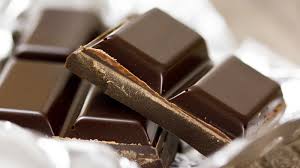CHOCOLATE
- Dr Adele Pelteret - Naturopath

- Sep 28, 2020
- 7 min read
Updated: Jan 21, 2023
This article on Chocolate was originally written for the SA Journal of Natural Medicine in 2014 and was again published in 2016.
Some people think chocolate is in its own separate food group. I personally think, as do many others, that it is an ‘essential’ superfood and that life would just not be the same without it.
Chocolate, derived from cocoa beans, has a long and interesting history. The word cacao has changed over the years to cocoa, and was taken originally from the Mayan and Aztec languages.
There are three main kinds of cocoa trees grown throughout the world, each with their own flavour, profiles and growth characteristics. There are also hundreds of different hybrids. Most cocoa trees are grown in areas between the tropics of Cancer and Capricorn – mainly in South America and West Africa.
FROM BEAN TO BAR
After harvesting, the beans and surrounding pulp are scooped out of the pods and left to ferment for up to six days. – a critical step for flavour. During this process the colour changes from purple to brown and the familiar cocoa smell emerges. The beans are then dried naturally for between 10 to 20 days after which they leave the cocoa plantations in this dry but raw state with the edible part still enclosed inside a hard skin. They are then bought by factories around the world.
Manufacturers have their own methods of roasting the beans to develop flavour, aroma and enrich the colour. The husks are removed after roasting and the beans are passed into the grinding mill. The final flavour is obtained by blending two, three or more types of bean after roasting. The formulas for these blends are jealously guarded secrets.
Melangeur
Pulverised sugar or artificial sweeteners, cocoa butter, and very small amounts of soy lecithin and vanilla are then added to this cocoa mass (also milk powder for milk chocolate) and thoroughly mixed on a melangeur (chocolate grinder) to form a dough-like consistency. The chocolate paste is refined by further grinding and then goes through the conching process.
Conching
Conching is the process whereby the chocolate is gently agitated over a period of up to seven days. During this stage the flavour of the chocolate is developed and mellowed, removing any residual bitterness, and the texture reaches that essential stage of velvety smoothness. Various flavours are added.
Tempering
Finally, the chocolate is returned to a liquid form by raising the temperature to 45°C in a process called tempering.
A chocolate maker starts with the raw product (cocoa beans) and transforms them into chocolate for eating or use in baking, or in some cases uses the raw cocoa beans themselves. Many chocolate companies buy ready-made chocolate/cocoa liquor to use as a basis and then add flavourings and other ingredients such as nuts. It is then ready to be moulded into bars and chocolates.
In general, the more additions to the original raw cocoa mass, the less healthy the chocolate becomes.
SOME HEALTH BENEFITS
Antioxidants
Chocolate contains beneficial chemicals known as polyphenols, i.e. potent antioxidants. Antioxidants neutralise free radicals (oxidants) which can accelerate cellular damage and ageing and their related health problems, but the more processing the raw cocoa undergoes, the fewer of these are present.(1)
Heart health
Several studies have shown that flavanols in cocoa beans increase nitric oxide (NO) production, which in turn reduces tension in blood vessels and improves bloodflow. (2,3)
Body mass index (BMI)
A large study showed that the BMI and the waist-to-hip ratio of dark chocolate consumers was lower than that of those who did not eat dark chocolate despite the fact that their physical exercise was lower. It was proposed that the amount of energy from dark chocolate is relatively low and so is the average age of those who eat dark chocolate – younger people generally have a lower BMI. Another explanation was that of the action of chocolate’s polyphenols on the body.(4)
A similar 2012 study (5) found that adults who eat a modest amount of chocolate on a regular basis had a lower BMI than those who did not. The chocolate eaters did not eat fewer calories or exercise more and no behavioural differences were noted. The researchers suggest that it may have something to do with ‘the composition of the calories, and not just the number of them’ that impacts on one’s weight. It was a small study but further studies of chocolate’s metabolic benefits in humans are definitely warranted.
Diabetes and insulin resistance
Dark chocolate, free of, or with a low sugar content, improves insulin sensitivity which will decrease blood glucose levels. Insulin resistance is also decreased by dark chocolate consumption. (6)
Inflammation
C-reactive protein (CRP), a marker for inflammation, decreases with moderate dark chocolate consumption. Abnormal CRP levels can mean many things, including conditions ranging from tuberculosis to a heart attack. The study suggests that the serum CRP-lowering effects of dark chocolate disappear with the consumption of more than 6.7 g/day, which is approximately one block of a slab, dependent on the thickness of the slab. Di Giuseppe suggests that this is why two small studies that previously attempted to prove that dark chocolate decreased inflammation failed to get the proposed result. (4)
The dietary habits of dark chocolate eaters were healthier too, including the higher consumption of nuts, seeds, fish, and lower consumption of tea and coffee. Although these are all great sources of antioxidants, when tested, they had no association with CRP reduction. This points more and more to the specific CRP-lowering effect of dark chocolate.(4)
MOOD AND COGNITIVE FUNCTION
A 2013 study 7 done on cocoa’s effects on the cognitive function of elderly adults gave promising results. Participants with cognitive impairment (namely dementia) prior to commencement of the experiment had significantly improved blood flow to the brain after the study. This resulted in them scoring higher on working memory tests after 30 days of consuming cocoa beverages. Those who had no previous cognitive impairment showed no difference in their test scores after the completion of the experiment.
The consumption of chocolate is said to improve one’s mood and increase feelings of pleasure by increasing the levels of serotonin (8) and endorphins in the brain. (9)
Some nutritional values in 6.5 g of dark chocolate (70 to 80% cocoa solids) – recommended daily dose.(10)
SOURCE: USDA, National Nutrient Database for Standard Reference, Release 26.
Potassium K 46 mg
Phosphorus P 20 mg mg
Sodium Na 1mg
Calcium Ca 5 mg
Magnesium MG 15 mg
Energy Kcal 39
Iron Fe 0.77 mg
Zinc Zn 0.21 mg
Total Lipids/Fat 2.77 g
Caffeine 5 mg
CONCLUSION
Further investigation is needed to support the findings and hypotheses made on the health benefits of dark chocolate. These studies should include researching the long-term effects, optimal doses and dietary influence on people of different ages and demographics.
Dark chocolate or raw cocoa can be a great form of nourishment, and is regarded as a superfood, BUT as long as it is added to a balanced diet. As with everything in life: Enjoy!
Delicious raw chocolate recipe
A dear friend of mine, Becky Hastings, who is an avid raw chocolate lover and ‘experimenter’, has kindly shared a favourite recipe with us.
Raw chocolate is something you can experiment with. It is really tasty, and good for you. Raw cacao powder is loaded with minerals and has an outrageously high ORAC* score. Coconut oil is a healthy fat which provides more benefits than I can explain!
IN A SMALL SAUCEPAN COMBINE, AND MELT SLOWLY ON THE LOWEST HEAT POSSIBLE (or you can use a double boiler if you have one):
¼ cup cacao butter
½ cup peanut butter (organic ground peanuts)
¾ cup coconut oil
¼ cup honey
BLEND IN A BLENDER OR FINELY CHOP AND ADD TO THE ABOVE MIXTURE WHEN IT IS FULLY MELTED:
A handful of goji berries
10 whole cacao beans
± ¼ cup pecans
± ¼ cup cashews
¼ to ½ cup coconut flakes (unsweetened)
ADD:
2 tbsp hemp seed
¼ to ½ cup raw cacao powder
A sprinkle of cinnamon
A pinch of salt
Stir together and put into silicon chocolate moulds, a glass dish, or BPA-free plastic containers. Put into the freezer until hard. You can keep the chocolate in the refrigerator or the freezer, cut into pieces as needed. Raw chocolate melts easily, so don’t hold it in your hands for long.
If you don’t have any cacao butter, goji berries, cacao beans or hemp, just leave it out! Don’t allow ‘not having all the ingredients’ keep you from experimenting with delicious raw chocolate. I add these superfoods to boost the nutritional value. If you do leave them out, you might need to add more cacao powder. You can vary the type and quantity of nuts depending on what you enjoy. In fact, you can vary just about everything!
*ORAC: Oxygen radical absorbance capacity is a method of measuring antioxidant capacities.
References
Andres-Lacueva C., Monagas M., et al. Flavanol and flavonol contents of cocoa powder products: influence of the manufacturing process. J Agric Food Chem. 2008 May; 14;56(9):3111-7.
Grassi, D., Lippi, C. et al. (2005). Short-term administration of dark chocolate is followed by a significant increase in insulin sensitivity and a decrease in blood pressure in healthy persons. American Society for Clinical Nutrition.(81):611-14. Available at: http://ajcn.nutrition.org/content/81/3/611.full.pdf+html?sid=52aa2005-0bcf-49b4-baa3-fcf1d537d27e
Live Science Website. Secrets to Chocolate’s Heart Benefits Found. 2006. Available at: http://www.livescience.com/561-secret-chocolate-heart-benefits.html
di Giuseppe, R., di Castelnuovo, A. et al. (2008). Regular Consumption of Dark Chocolate Is Associated with Low Serum Concentrations of C-Reactive Protein in a Healthy Italian Population. The Journal of Nutrition: Nutritional Epidemiology. (138):1939-45. Available at: http://jn.nutrition.org/content/138/10/1939.full.pdf+html
Golomb B. et al. Association between More Frequent Chocolate Consumption and Lower Body Mass Index. JAMA Internal Medicine (formerly Arch Intern Med.) 2012; 172(6):519-521). Available at: http://archinte.jamanetwork.com/article.aspx?articleid=1108800
Faridi, Z., Njike, V.Y. et al. Acute dark chocolate and cocoa ingestion and endothelial function: a randomized controlled crossover trial. 2008; American Society for Clinical Nutrition. (88): 58-63. Available at:http://ajcn.nutrition.org/content/88/1/58.full.pdf+html?sid=52aa2005-0bcf-49b4-baa3-fcf1d537d27e
Farzaneh A., Sorond, F.A., et al. Neurovascular coupling, cerebral white matter integrity, and response to cocoa in older people. American Academy of Neurology. 2013; (81):863-64. Available: at: http://www.neurology.org/content/early/2013/08/07/WNL.0b013e3182a351aa
Healing Foods Pyramid: Dark Chocolate. Nutrition Education Team at the University of Michigan Integrative Medicine. 2009. Available at: http://www.med.umich.edu/umim/food-pyramid/dark_chocolate.htm
Dyer, K.A. 2006. Chocolate: Good for the Mind, Body & Spirit, Medical Wellness Archives. 2006; (3): Number 1. Available at: http://www.medicalwellnessassociation.com/articles/chocolate_benefits.htm
Davison K., Coates A.M., et al. (2008). Effect of cocoa flavanols and exercise on cardiometabolic risk factors in overweight and obese subjects. International Journal of Obesity. (32): 1289-96. Available at: http://www.nature.com/ijo/journal/v32/n8/pdf/ijo200866a.pdf
.png)
















Comments